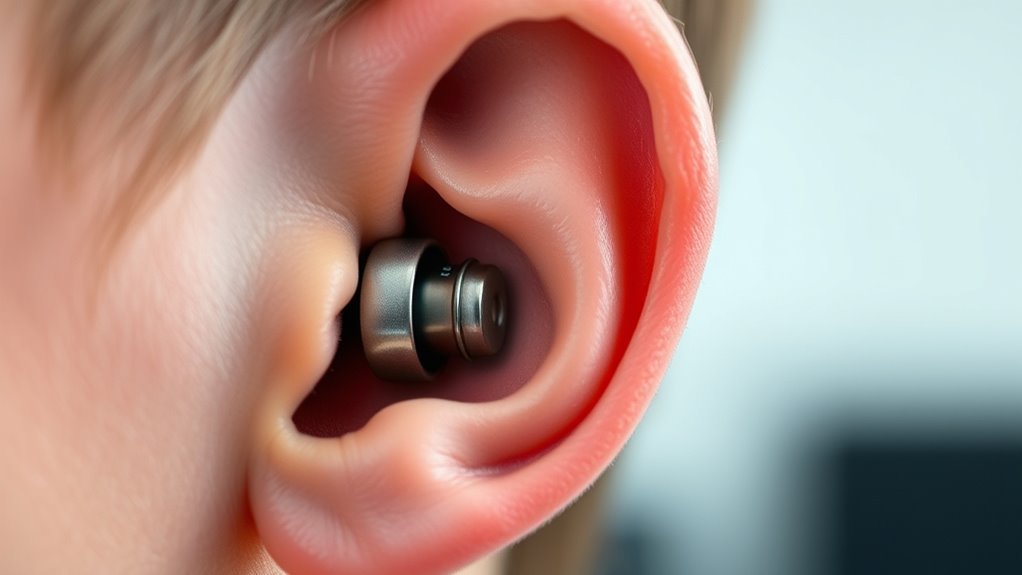If you have moderate to severe hearing loss and traditional aids aren’t helping, a middle ear implant might be right for you. They’re recommended if you’ve experienced discomfort, cosmetic concerns, or limited benefit from hearing aids, especially with ear anatomy issues or other medical conditions. These implants offer better sound quality, discreet design, and durability. To find out more about your suitability and options, keep exploring how these innovative solutions could work for you.
Key Takeaways
- Recommended for moderate to severe sensorineural or conductive hearing loss unresponsive to traditional hearing aids.
- Suitable for candidates seeking discreet, natural-looking hearing solutions with improved sound quality.
- Ideal for individuals with ear anatomy issues, previous ear surgeries, or ear infections that limit hearing aid effectiveness.
- Suitable for patients experiencing discomfort or dissatisfaction with external hearing aids.
- Considered when surgical intervention offers long-term durability and improved sound clarity over conventional devices.
Candidates for Middle Ear Implant Surgery

Candidates for middle ear implant surgery typically include individuals with moderate to severe sensorineural hearing loss who haven’t benefited enough from conventional hearing aids. If you have specific music preferences and find that hearing aids distort sound quality or aren’t satisfying, a middle ear implant might be a better option. You may also have cosmetic concerns about visible hearing devices, especially if they affect your confidence or appearance. These implants can offer a discreet alternative, improving sound clarity while maintaining a natural look. Generally, candidates seek improved hearing performance and are comfortable with surgical procedures. It’s essential to discuss your unique needs, including your musical interests and aesthetic preferences, with an audiologist to determine if a middle ear implant aligns with your hearing goals. Supporting children through divorce and managing emotional well-being are also important considerations when making healthcare decisions.
Types of Hearing Loss Suitable for Implants
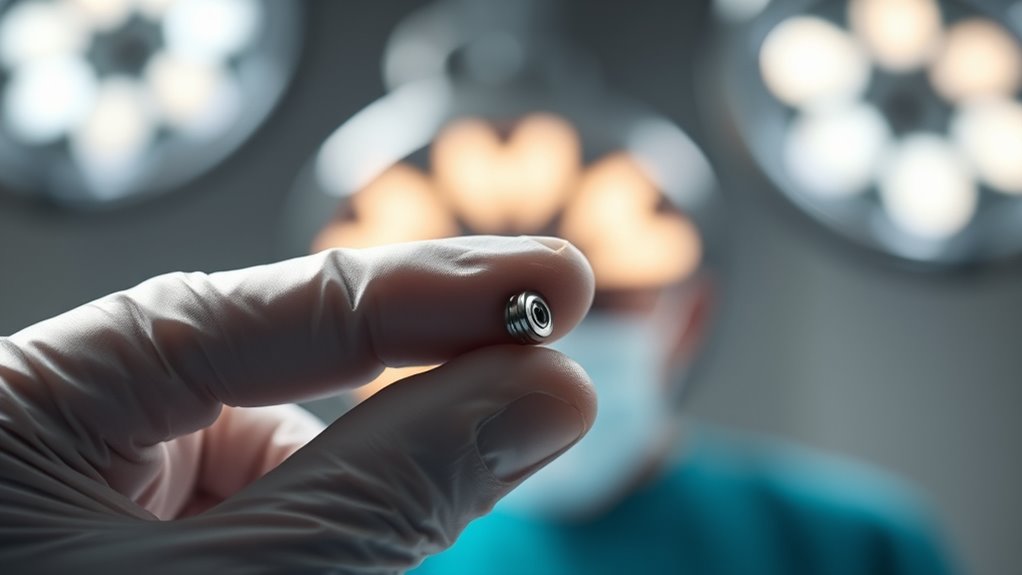
Middle ear implants are primarily designed for individuals with specific types of hearing loss that can benefit from direct stimulation of the ossicular chain or inner ear structures. These implants are suitable when traditional hearing aids aren’t effective or cause cosmetic concerns. Here are some common types:
- Conductive hearing loss caused by issues in the outer or middle ear.
- Mixed hearing loss involving both conductive and sensorineural components.
- Sensorineural loss where traditional hearing aids produce limited benefit.
- Hearing loss with cosmetic considerations, as implants are discreet compared to external devices.
Keep in mind, cost implications vary depending on the device and procedure, making middle ear implants a tailored option for certain needs. Your audiologist can help determine if your type of hearing loss qualifies.
Severity of Hearing Loss and Implant Eligibility

The severity of your hearing loss plays a crucial role in determining whether you’re eligible for a middle ear implant. Generally, these devices are recommended for individuals with moderate to severe sensorineural hearing loss when traditional hearing aids don’t provide sufficient benefit. Cost considerations can be significant, as middle ear implants tend to be more expensive upfront than hearing aids, and insurance coverage varies. Some insurance plans may cover part of the procedure, but it’s essential to verify your coverage beforehand. If your hearing loss is too mild, an implant might not be suitable, and other options could be better. Consulting with an audiologist or ENT specialist will help you assess your eligibility based on hearing severity, costs, and insurance factors. Additionally, ongoing advancements in AI safety measures are improving diagnostic tools and treatment options for hearing impairments.
Previous Hearing Aid Use and Outcomes

If you’ve been using hearing aids, your experience offers valuable insight into whether a middle ear implant might suit you. Consider these factors:
- Cosmetic concerns: If you find hearing aids bulky or visible, implants may offer a discreet alternative.
- Device compatibility: If your hearing aids haven’t provided satisfactory amplification due to compatibility issues, a middle ear implant might improve performance.
- Previous outcomes: If hearing aids didn’t meet your expectations or caused discomfort, implants could offer better comfort and function.
- Adaptation experience: Your ability to adjust to hearing devices helps determine if a more permanent solution like an implant is suitable.
Your past hearing aid use guides your suitability, especially when cosmetic concerns and device compatibility are significant.
Medical Conditions Affecting Implant Suitability
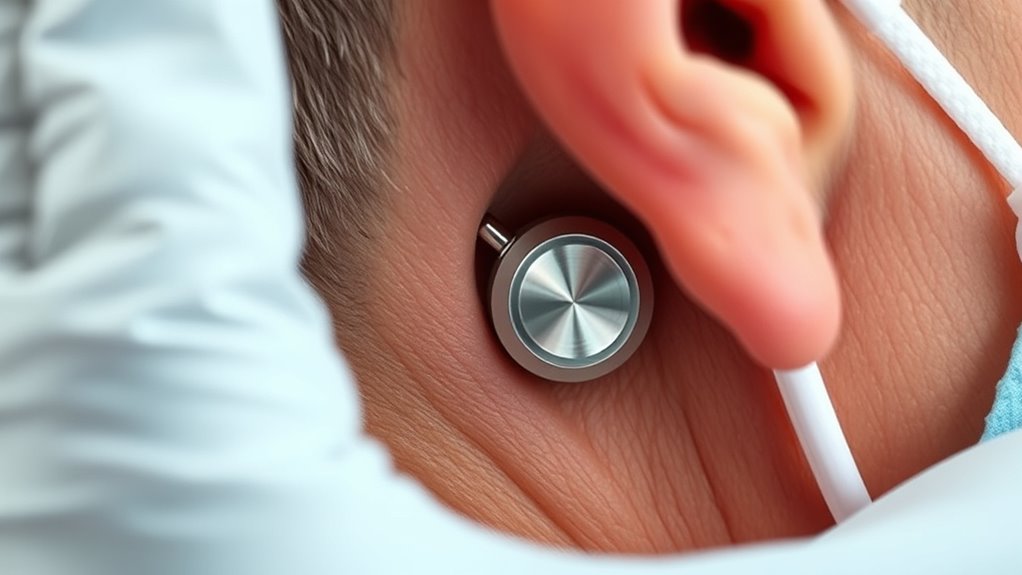
Your ear’s anatomy, existing middle ear diseases, and congenital conditions can influence whether a middle ear implant is suitable for you. Variations or abnormalities may increase risks or complicate the procedure. Understanding these factors helps determine the best treatment options for your hearing needs. Additionally, ongoing advances in medical technology are expanding options for individuals with complex ear conditions.
Ear Anatomy Variations
Variations in ear anatomy can substantially influence whether you’re a suitable candidate for middle ear implants. Issues like a narrow or malformed ear canal may hinder device placement or stability. Additionally, an abnormally shaped or blocked eustachian tube can affect pressure regulation and healing. Here are key anatomical factors to consider:
- Ear canal size and shape, which impact surgical access.
- Eustachian tube function, influencing middle ear pressure and ventilation.
- Ossicular chain structure, affecting how the device interacts with ear bones.
- Presence of congenital deformities or prior surgeries that alter normal anatomy.
Understanding these variations helps determine if a middle ear implant will be effective and safe for you. Proper assessment ensures the best outcome tailored to your unique ear structure.
Middle Ear Disease Risks
Did you know that existing middle ear infections or other medical conditions can considerably impact whether a middle ear implant is a safe and effective option for you? Active ear infections or allergy concerns might increase the risk of complications or reduce the implant’s effectiveness. If you have a persistent ear infection, surgery could worsen your condition or delay healing. Allergies to materials used in implants can cause inflammation or discomfort, making the procedure unsuitable. Before proceeding, your doctor will evaluate your medical history and current ear health. Consider the following factors:
| Medical Condition | Effect on Surgery | Recommendation |
|---|---|---|
| Ear infection | May cause infection spread | Treat infection before surgery |
| Allergy concerns | Risk of allergic reactions | Material testing needed |
| Chronic inflammation | Impairs healing | Address inflammation first |
Congenital Ear Conditions
Congenital ear conditions are structural or developmental abnormalities present from birth that can markedly influence the success of a middle ear implant. These conditions may affect the anatomy of your ear, making implantation more complex or less effective. To determine suitability, audiological assessments are essential to evaluate hearing loss severity. Speech therapy might be recommended post-implant to improve communication skills. Consider these factors:
- Abnormal ear structures that hinder device placement
- Inner ear malformations impacting hearing outcomes
- Associated syndromes affecting ear development
- Need for thorough audiological assessments before surgery
Additionally, understanding the specific ear anatomy can help in planning the most effective intervention strategies. Addressing these issues early with proper evaluations guarantees you get the most benefit from the implant and tailored speech therapy to optimize hearing and communication.
Benefits Over Traditional Hearing Aids
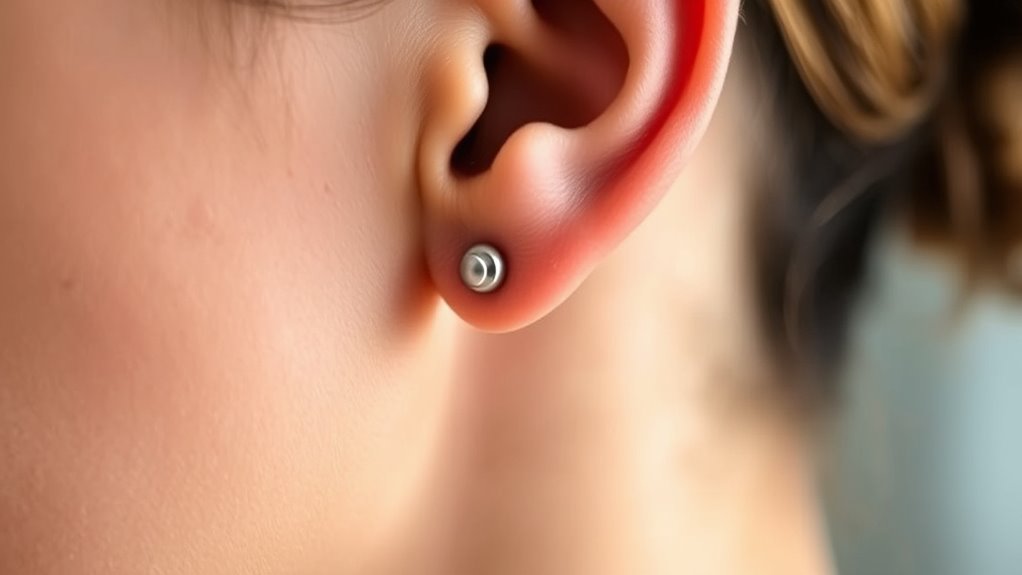
Middle ear implants offer you better sound quality than traditional hearing aids, making it easier to understand speech and enjoy your surroundings. They also require less maintenance, so you spend less time on adjustments and troubleshooting. Plus, their enhanced comfort and secure fit mean you’ll hardly notice you’re wearing them throughout the day. Incorporating content relevance and authority into your choice can further enhance your hearing experience.
Better Sound Quality
Unlike traditional hearing aids, middle ear implants often provide clearer, more natural sound quality because they directly stimulate the ossicles or inner ear structures. This direct stimulation results in better sound fidelity, especially in noisy environments. Additionally, these implants can improve speech understanding, making conversations more comfortable. When considering cost considerations, middle ear implants tend to be more expensive upfront but may save money long-term due to durability. The cosmetic appearance is also a significant benefit; since the device is implanted, there’s no bulky device visible behind your ear. This discreet design appeals to many users seeking a more natural look. Moreover, advances in Glycolic Acid skin care demonstrate how targeted treatments can enhance overall skin health, emphasizing the importance of innovative solutions. Overall, if sound quality and appearance matter most to you, middle ear implants offer notable advantages over traditional hearing aids.
Reduced Maintenance Needs
Because they are implanted internally, middle ear implants generally require less ongoing maintenance than traditional hearing aids. Since the device is embedded within your ear, there’s no need for frequent cleaning or filter replacements, reducing routine care. The device’s durability means it’s less prone to damage from moisture, earwax, or impact, further decreasing maintenance needs. Additionally, because the implant is hidden beneath the skin, aesthetic considerations are minimized—there’s no visible component to worry about or adjust. This internal setup not only simplifies your upkeep but also ensures consistent performance over time. With fewer parts exposed to external elements, you spend less time on repairs or adjustments, making middle ear implants a low-maintenance solution suited for long-term convenience. Furthermore, the design minimizes external exposure, enhancing the device’s longevity and reliability.
Enhanced Comfort and Fit
One of the main advantages of middle ear implants is their enhanced comfort and fit, which often surpasses that of traditional hearing aids. You’ll notice they sit discreetly inside your ear, improving cosmetic appearance and reducing the visibility of devices. Unlike traditional aids, they eliminate the need for bulky external components that can cause irritation or discomfort. Additionally, the surgical complexity is carefully managed to ensure a secure fit, making the device feel more natural. Here are some benefits:
- Improved cosmetic appearance due to discreet placement
- Less irritation and discomfort from external parts
- Better stability and secure fit with tailored surgical procedures
- Reduced awareness of the device, enhancing confidence and comfort
Furthermore, these implants are designed to work with the ear’s natural anatomy, which can lead to a more comfortable listening experience and better sound quality for the user.
Potential Risks and Considerations
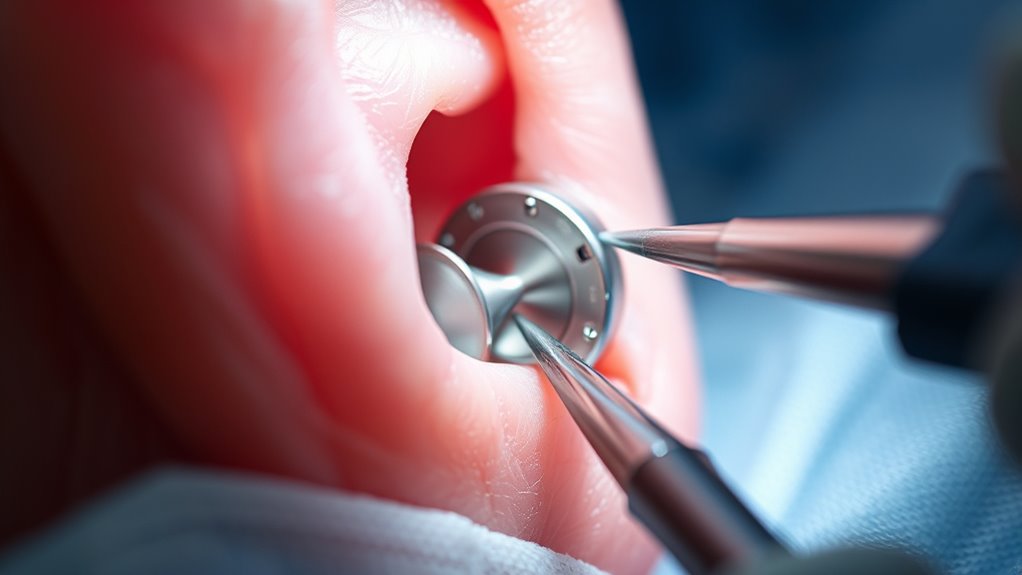
While middle ear implants offer many benefits, they also come with potential risks and considerations that you should be aware of. One concern is cosmetic, as the device and surgical scars may be visible or cause aesthetic worries. Surgical risks also exist, including infection, bleeding, or damage to surrounding structures. You might experience discomfort or temporary pain during recovery. Additionally, there’s a chance the implant may not fully improve your hearing or could require further adjustments or procedures. It is crucial to weigh these risks with your healthcare provider to determine if the benefits outweigh potential complications. Understanding these considerations helps you make an informed decision about whether a middle ear implant is suitable for your needs. Moreover, retail hours for related services can impact post-surgical checkups and maintenance visits.
Frequently Asked Questions
How Long Is the Recovery Period After Middle Ear Implant Surgery?
After middle ear implant surgery, you’ll typically experience a recovery period of a few days to a week. During this time, the rehabilitation process begins, and you should follow post-surgery care instructions carefully. Rest is essential, and you may need to avoid strenuous activities. Your healthcare provider will guide you through the steps to ensure proper healing and best use of your implant, helping you regain hearing effectively.
What Is the Typical Lifespan of a Middle Ear Implant Device?
Think of your middle ear implant as a reliable partner on your hearing journey. Typically, these devices have a durability of 5 to 10 years, depending on usage and care. The battery lifespan usually lasts 3 to 7 days before needing a recharge or replacement. Regular check-ups help guarantee your device functions smoothly, so you can enjoy clear sound without interruption. Proper maintenance extends your device’s life, keeping your hearing sharp.
Are Middle Ear Implants Suitable for Children or Only Adults?
You might wonder if middle ear implants are suitable for children or only adults. Generally, pediatric candidacy depends on developmental considerations, such as age and ear anatomy. Surgeons carefully evaluate whether a child’s ear structure supports the device and if their developmental stage allows for effective use. While more common in adults, some children may qualify, especially when traditional hearing aids aren’t effective, making early intervention beneficial.
Can Middle Ear Implants Be Used Alongside Cochlear Implants?
Think of combination therapy as a symphony where different instruments work together. You might wonder if middle ear implants can be used alongside cochlear implants. The answer is yes—implant compatibility allows for this. Combining these devices can enhance hearing outcomes, especially in complex cases. Always consult your audiologist to evaluate compatibility and determine if this approach suits your specific hearing needs, creating a harmonious hearing experience.
What Are the Maintenance Requirements for Middle Ear Implants?
You need to regularly maintain your middle ear implant by cleaning the device as recommended by your audiologist to guarantee ideal performance. Battery management is also essential; you’ll want to monitor and replace or recharge the batteries as needed. Keep your device dry and avoid exposure to extreme temperatures. Routine check-ups help identify any issues early, ensuring your implant functions smoothly and lasts longer.
Conclusion
If you’re considering a middle ear implant, it’s worth questioning whether this technology truly offers better hearing than traditional aids. While many find improved clarity and comfort, not everyone is a perfect candidate. Consult with your audiologist to assess your hearing loss severity, medical conditions, and previous aid outcomes. Remember, while implants can be life-changing, they aren’t suitable for everyone—so stay informed and explore all options before making your decision.

